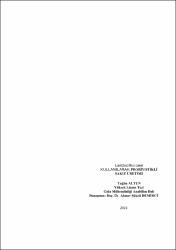| dc.contributor.author | Altun, Tuğba | |
| dc.date.accessioned | 2020-01-30T08:09:45Z | |
| dc.date.available | 2020-01-30T08:09:45Z | |
| dc.date.issued | 2019 | |
| dc.identifier.uri | https://hdl.handle.net/20.500.11776/3512 | |
| dc.description.abstract | Bu araştırmada, farklı oranlarda (%1, %2, %3) probiyotik bakteri (L.casei) ilave edilmesi suretiyle şekerli ve şekersiz sakız üretilmiştir. Aynı zamanda sakızlara prebiyotik (inülin) ilavesi yapılarak probiyotik bakterinin sakız içerisindeki canlılığını daha uzun süre korumak hedeflenmiştir. Sakız ürününe katılan çeşitli oranlardaki probiyotik bakterinin depolama boyunca (0, 7, 14 ve 21. gün) canlılık seviyesi izlenmiştir. Probiyotik canlılık analizinin 21 günlük depolama sonucunda, bütün örneklerde probiyotik özelliğin (>107) devam ettiği belirlenmiştir. 21. gün depolama sonrasında şekerli sakız örnekleri içerisinde en yüksek canlılık %1 probiyotikli prebiyotikli şekerli sakız iken (8,11 log kob/g) şekersiz sakız örnekleri içerisinde %2 probiyotikli prebiyotikli şekersiz sakız (8,45 log kob/g) olduğu tespit edilmiştir. Tekstür sonuçları incelendiğinde, 0 ve 21. gün takibi sonrası şekerli ve şekersiz sakız ürünlerinde sakızın sertliğinde artış belirlenmiştir. Yapışkanlık ve çiğnenebilirliği açısından istatistiksel fark bulunamamıştır (p<0.05). Yapılan çalışma sonucunda; %3 probiyotik ilaveli sakız grubunda 21 günlük depolama boyunca, canlılık üzerinde prebiyotik etkisinin olmadığı tespit edilmiştir. | en_US |
| dc.description.abstract | In this study, sugary and unsweetened gum was produced by adding probiotic bacteria (L.casei) at different rates (1%, 2%, 3%). At the same time, it was aimed to preserve the viability of probiotic bacteria in gum for a longer period by adding prebiotic (inulin) to the gums. The viability of various proportions of probiotic bacteria incorporated into the gum product was monitored during storage (day 0, 7, 14 and 21). After 21 days storage of probiotic viability analysis, it was determined that probiotic property (> 107) was maintained in all samples. The highest viability of sugary gum samples after storage on day 21 was found to be prebiotic sugary gum with 1% probiotic (8.11 log cfu / g) and 2% probiotic prebiotic sugar free gum (8.45 log cfu / g) with sugar free gum samples. When the texture results were examined, it was determined that the hardness of the gum was increased in the sugary and unsweetened gum products after 0 and 21 days follow-up. No statistically significant difference was found in terms of stickiness and chewability (p <0.05). As a result of the study; During the 21 days of storage in the 3% probiotic supplemented chewing gum group, no prebiotic effect on viability was found. | en_US |
| dc.language.iso | tur | en_US |
| dc.publisher | Namık Kemal Üniversitesi | en_US |
| dc.rights | info:eu-repo/semantics/openAccess | en_US |
| dc.subject | Probiyotik | en_US |
| dc.subject | L. casei | en_US |
| dc.subject | sakız | en_US |
| dc.subject | prebiyotik | en_US |
| dc.subject | canlılık | en_US |
| dc.subject | tekstürel yapı | en_US |
| dc.subject | gum | en_US |
| dc.subject | paribiotic | en_US |
| dc.subject | liveliness | en_US |
| dc.subject | textural construction | en_US |
| dc.title | Lactobacillus casei kullanılarak probiyotikli sakız üretimi | en_US |
| dc.title.alternative | PROBIOTIC GUM PRODUCTION USING Lactobacillus casei | en_US |
| dc.type | masterThesis | en_US |
| dc.department | Enstitüler, Fen Bilimleri Enstitüsü, Gıda Mühendisliği Ana Bilim Dalı | en_US |
| dc.relation.publicationcategory | Tez | en_US |



















